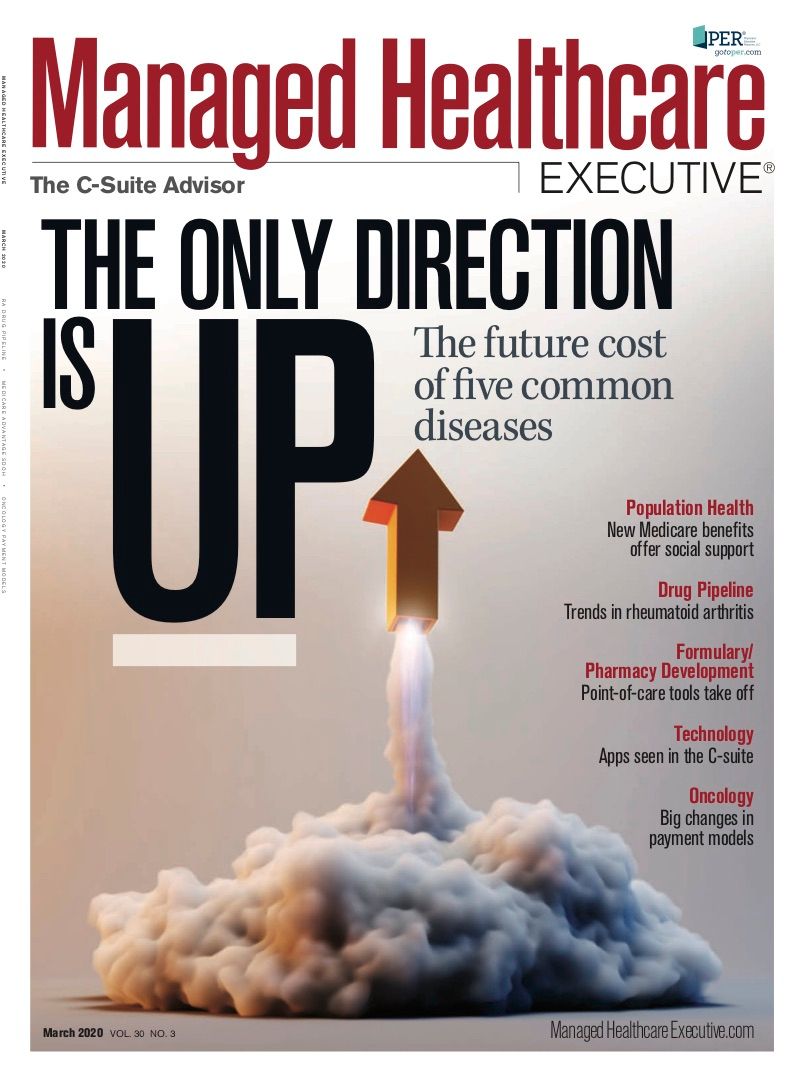Point-of-Care Tools in Pharmacy Take Off
New point-of-care tools offer greater transparency.

New point-of-care (POC) tools that promote communication between providers and patients are establishing themselves as next generation shared decision-making solutions, especially when it comes to medications and issues of insurance coverage, price, and out-of-pocket costs.
“When compared to traditional shared decision-making tools, there’s an increased emphasis not just on improving measures such as medication adherence by involving the patient in his or her own care but also on using this education and engagement to improve patient satisfaction,” says Chuck Lee, MD, senior director of clinical knowledge and Meducation at First Databank, a San Francisco company medical data company.
Meducation, which uses research-based health literacy approaches to simplify medication instructions, was focused solely on providing key instructional and adherence tools related to medications self-administered at home. Now its new content is designed to directly address Hospital Consumer Assessment of Healthcare Providers and Systems (HCAHPS) patient satisfaction questions on newly administered inpatient medications, including 200 new intravenous drug forms and hospital-administered medications.
Lee says that access to these point-of-care tools has been enhanced. With Meducation, all patient education materials are automatically made available through the patient portal or via a standalone portal. It’s a brand new, patient-facing world for these POC tools.
“Many of the older shared decision-making tools were designed to be used exclusively by providers of care and not to interact with patients,” notes Heidi Polek, RPh, senior manager, independent pharmacy solutions for DrFirst, an e-prescribing and patient medication management company in Rockville, Maryland.
A Humana, Epic collaboration
Joel Jones, PharmD, director, population health informatics for Epic, says the new tools are being embedded directly into physicians’ workflows with built-in next steps that allow them to easily and efficiently swap in a more cost-effective drug. Alan Wheatley, president of Humana’s retail segment, agrees that one of the primary old vs. new differences in decision-making tools is that the new ones can be integrated into a physician’s workflow. There’s also added interoperability.
Humana has partnered with Epic to integrate IntelligentRX, its real-time benefits check tool, into Epic’s e-prescribing workflow. The result is real-time access to a patient’s medical history, health insights, and treatment options.
Related: Preparing Pharmacy for Performance-Based Reimbursement
The EHR software enables clinicians to immediately estimate the cost of a medication and share it with a patient by factoring in copayments, deductibles, and a need for prior authorization. The application sends an alert about less expensive options. The software also helps physicians to avoid gaps in care by, for example, reminding a patient that she is due to have a mammogram soon.
“Our relationship with Humana is an opportunity to help patients and prescribers work more collaboratively with payers, streamline procedures, and integrate information into a doctor’s workflow,” says Jones.
One of the benefits, Jones continues, is limiting prescribing fatigue on the part of providers because they are dealing with information that is accurate and can be acted upon, based on a patient’s coverage. It also promotes communication among payers, clinicians, and patients and puts data on a common platform, he says.
Humana’s Retail Segment President, Alan Wheatley, says there is more interest in the tool than expected, and he anticipates it will improve quality and positively play out in CMS’ Star Rating system.
Other companies are also folding insurance coverage information into workflows and platforms. Allscript, a Chicago EHR technology company, offers a transparency feature from Veradigm, a health information technology company, called TruePriceRx accessed through its electronic prescribing platform to improve adherence and reduce the need to change a patient’s therapy because of unexpected cost or prior authorization. TruePriceRx offers real-time prescription pricing information within the prescribing workflow-all at the point of care. Providers can use the information to discuss pricing options with their patients, increasing consumer empowerment and satisfaction, and when that happens, the likelihood of medication adherence increases.
Cheaper alternatives
“The tool helps get patients on the right therapy and improves patient-physician dialogue because a clinician receives the price of a drug in the EHR to pass along to patients -before they go to a pharmacy,” says Jill Helm, vice president, product management, Allscripts. Then, says Helm, the physician may have the opportunity to recommend an alternative medication that is less expensive or one that might be ordered for 90 days instead of 30.
“It is difficult for patients to admit they cannot afford a drug and force them to ration it-or not take it at all,” says Helm.
Transparency tools are gaining traction and it's anticipated that when the regulation requiring Part D sponsors to adopt one or more real-time benefit tools that are capable of integrating with at least one prescriber’s e-prescribing system or EHR goes into effect next year, adoption will really pick up steam, she says. Helm also attributes the growing interest and adoption to the complexity of benefits and to the trend away from simple copays toward high deductible coverage and high out-of-pocket costs. An Allscripts’ survey found that 60% of participants said adherence improved when patients received pricing information.
Helm says the price transparency tool also helps patients choose the best pricing model through their insurance plan or whether to pay cash. It can also help select a pharmacy that will support the best adherence to prescription therapy.
Polek says that DrFirst offers a patient engagement tool called RxNotification, a single secure message from a participating prescriber or pharmacy to a patient, with information on pricing and affordability; why the drug has been prescribed; clinical information; how to take the drug; and cost savings.
“RxNotification helps reduce adherence barriers and alleviate cost issues,” Polek says. “It also combats issues of price transparency because patients can see prices before a prescription is complete and decide if they can afford it, thus reducing drug abandonment.” The tool has proved to reduce drug abandonment by 6%, according to Polek.
Another tool, Backline, is a web-based, HIPAA-secure service environment in which all shareholders-providers, hospitals, long-term care facilities and pharmacies-ask questions and share patient data via encrypted, text-style messaging, replacing phone calls, texts, faxes and emails. Polek says Backline sold to hospital and physician practices and later to insurers, enables participants to exchange messages about whether a drug is covered under a patient’s plan.
RxAdvance, a national, full-service PBM, leverages its Collaborative PBM cloud platform to provide all stakeholders with a comprehensive view of a patient’s health and medication regimen. The platform allows review and optimization of a member’s prescription regimen to proactively prevent adverse drug events and eliminates duplicate therapies.
“The cloud model reduces costs and allows for more efficient and streamlined communication amongst stakeholders in the field of care,” says John Sculley, former CEO of Apple and co-founder of RxAdvance.
Sculley attributes the rise of pharmacy tools to a higher demand for a streamlined and data-driven process as more patients receive care at home. He says the egregious cost of drugs is another factor. RxAdvance has enabled a 10% to 12% reduction in overall pharmacy costs; a 10% to 15% reduction in specialty pharmacy costs; and a 20% to 25% reduction in avoidable drug-impacted medical costs.
“Using RxAdvance’s collaborative PBM cloud can empower pharmacists to make critical decisions at the point of sale to help improve adherence and also to reduce avoidable medical costs,” Sculley says.
Mari Edlin, contributor based in Sonoma, California.

In the Scope of Virtual Health and the Future of “Website” Manner, Per Ateev Mehrotra
August 10th 2023Briana Contreras, an editor of Managed Healthcare Executive, had the pleasure of catching up with MHE Editorial Advisory Board Member, Ateev Mehrotra, MD, MPH, who is a professor of healthcare policy at Harvard Medical School and an Associate Professor of Medicine and Hospitalist at Beth Israel Deaconess Medical Center.
Listen
David Calabrese of OptumRx Talks New Role, Market Insulin Prices and Other Topics 'On His Mind'
April 13th 2023In this month’s episode of the "What's On Your Mind podcast," Peter Wehrwein, managing editor of MHE connects with the now Chief Clinical Officer of OptumRx Integrated Pharmacies, David Calabrese. In this conversation, David touches on his transition in January as OptumRx’s former chief pharmacy officer and market president of health plans and PBMs to his new role as Chief Clinical Officer where he now focuses more on things such as specialty pharmacy to home delivery — with an overall goal of creating whole-patient care. Throughout the conversation, Calabrese also touched on the market’s hot topic of insulin prices and behavioral health services within the OptumRx community, among other topics.
Listen